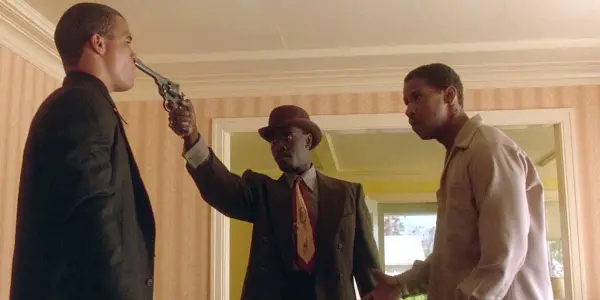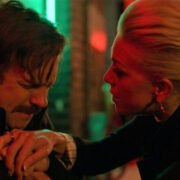DEVIL IN A BLUE DRESS: Where Film Noir Tackles Race Relations

Alex Nguyen is a film and music writer based in…
In 1995, Devil in a Blue Dress didn’t receive the recognition it deserved. Despite positive reviews, the film failed financially and struggled to make a dent in the cultural zeitgeist. However, its themes on race, in particular the struggles of Black Americans post-WWII, still resonate to this day. Looking back, it belongs to an esteemed group of films in the ’90s that tackled race in the predominantly-white genre of noir. These films all had their own unique styles, expanding the boundaries of the genre. By opening in a new Hollywood market of Black stories told by Black people, the films had the ability to hold a critical light on the nation’s foundational power structures. Upon the film’s July release into The Criterion Collection, it’s well worth a revisit.
Film Noir Revisionism
In its heyday in the ’40s and ’50s, noir was one of the film’s sharpest genres, revealing society’s ugly underbelly at the heart of the American Dream. These films were born out of the changing gender, racial, and economic landscape of America during and after WWII. Their cynical detectives often found that they weren’t cynical enough as they uncovered conspiracy and corruption among the wealthy elite. Although the genre was recognized for its powerful examinations of the sociopolitical ills of the time, it mostly avoided issues of race – something inseparable from America’s history. This changed in the ’90s when noir films like Deep Cover, One False Move, and Dead Presidents depicted how racism not only existed but was perpetuated by society.

Devil in a Blue Dress follows Ezekiel “Easy” Rawlins (Denzel Washington), a World War II veteran trying to make it after the war by moving to Los Angeles to work as a machinist. He’s not a typical film noir lead with a tragic backstory. Instead, Rawlins is simply trying to pay off his mortgage. When Rawlins loses his job, the violent DeWitt Albright (Tom Sizemore) pays him to find Daphne Monet (Jennifer Beals), the missing fiancée of mayoral candidate Todd Carter (Terry Kinney). From here, the story adheres to a standard noir structure. The case itself is more dangerous than Rawlins bargained for, forcing him into a world of murder and betrayal at the intersection between the criminal underworld and high society. He’s backed into a corner numerous times and has to figure out who he can depend on as politicians, police, shady figures, and the wealthy elite all try to take advantage of him.
The noir influences go even further than the plot. Cinematographer Tak Fujimoto captures Rawlins through long tracking shots, dissolves, and superimposes images. However, some tropes may be frustrating to some with Rawlins often ineffectual to the story, and sidelined to an observer, especially in the opening sequences. Because the film sticks closely to the protagonist’s perspective, many important plot points occur offscreen and are only explained later in voiceover narration. In this way, Devil in a Blue Dress is much more concerned with the atmosphere, themes, and characters than the action. The film also concludes with a standard conflicted ending where many characters’ stories are left unresolved.

However, director Carl Franklin also deviates from the genre in interesting ways. In addition to confronting racial issues, the film’s characters exist outside convention. Rawlins is given more humanity and depth than most noir protagonists. He has carved out a middle-class life for himself with his most prized possession being his house. He is also written as a flawed character who sleeps with his friend’s girlfriend to get information on Monet. Rawlins is also different from classic noir detectives in that he isn’t a loner. Instead, he is a member of a vibrant Black community with both friends and enemies. Likewise, although she is the titular “devil,” Monet is not a typical femme fatale. She is allowed to be vulnerable with the realization of her true identity being the heartbreaking and poignant crux of the film.
Examining Race
Race and identity are at the core of everything that happens to Rawlins. When he loses his job at the aircraft factory, it’s based on prejudice – the white employees keep their jobs, and Rawlins is called “fella” by his boss instead of his real name. Albright hires Rawlins for his ability to access the juke joints that Monet frequents without drawing attention and subjects him to many racial threats. He’s also beaten by the LAPD and has an altercation with a group of white teens. The film rightly suggests that the freedom and prosperity of the American Dream is an impossibility for Black people.
Conclusion
As an adaption of a series of Walter Mosley novels, Devil in a Blue Dress feels like a missed opportunity. Washington’s standout performance as Rawlins is full of charisma, and Don Cheadle’s breakout performance as Mouse is delightfully sociopathic. A series of neo-noir films starring the pair would be an exciting vehicle for examining the ever-evolving racial dynamics of America into the ’50s and ’60s. Although the film’s strict genre elements can be frustrating and its narrative occasionally jumbled, it is impactful on its own as its tragic story has little to do with the conspiracies, instead depicting the characters’ futile fight for societal acceptance.
Have you seen Devil in a Blue Dress? What did you think of it? Let us know in the comments below!
Devil in a Blue Dress is on HBO Max and is available in the Criterion Collection!
Watch Devil in a Blue Dress
Does content like this matter to you?
Become a Member and support film journalism. Unlock access to all of Film Inquiry`s great articles. Join a community of like-minded readers who are passionate about cinema - get access to our private members Network, give back to independent filmmakers, and more.
Alex Nguyen is a film and music writer based in New Jersey. You can find his writing on film at Spectrum Culture, Collider, and Inverse among others.










